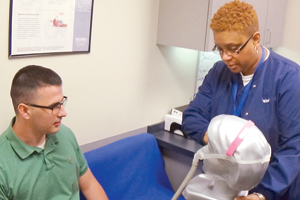Sleep Apnea Programs for Truck Drivers Enhanced by Data, ‘Workflow’ Systems

This story appears in the May 9 print edition of iTECH, a supplement to Transport Topics.
Advances in technology are making it easier for fleets to screen drivers for a medical condition that’s believed to be a significant contributor to preventable crashes, while also enabling health care providers to monitor treatment while drivers are on the road.
Sleep apnea — more specifically obstructive sleep apnea, or OSA — is estimated to affect one in five adults, according to numerous studies, and the numbers in trucking may be even higher.
The Mayo Clinic defines OSA as “a potentially serious sleep disorder in which breathing repeatedly stops and starts during sleep,” when throat muscles intermittently relax and block the airway.
Anyone can develop the condition, though it most commonly affects middle-aged and older adults and people who are overweight, two factors that are prevalent in trucking.
COMING MAY 18: LiveOnWeb on Driver Health, Wellness From A to Zzzzz
BEST OF MAY iTECH: More stories, columns
While this condition can to lead to serious medical problems for those who suffer from it, from a truck safety standpoint its biggest danger is excessive daytime sleepiness. According to a recent study co-authored by the Virginia Tech Transportation Institute, drivers with untreated sleep apnea are at five times the risk of a severe crash.
In early March, the Federal Motor Carrier Safety Administration and the Federal Railroad Administration said they were seeking public input on screening, evaluating and treating truck drivers and rail workers for OSA. This could be the first step toward tighter regulation of the condition among these workers.
To combat the disorder, some health care companies are using data platforms to streamline diagnosis and improve treatment for drivers, and several motor carriers said they have seen improvements in safety and driver satisfaction as a result.
Making all this possible is the ability to screen and diagnose drivers while they are on the road. This is a big improvement from the traditional method of taking time off to go to a sleep lab for overnight testing hooked up to machines.
“The lab tests can cost upwards of a thousand dollars to several thousands of dollars, where the home sleep test is a matter of a few hundred dollars,” said Bob Hoffman, president of National Sleep Services. “You also have decreased wait time. It’s not uncommon to have to schedule for sleep labs weeks or even months out, whereas our sleep tests can be scheduled and done within a matter of days.”
NSS was formed five years ago to address transportation industry needs in screening and treating people for OSA. The company, which is a division of medical equipment provider VGM Group, said it currently is helping some 8,000 truckers.
The “home sleep test” Hoffman referred to is commonly known as “mobile sleep testing” and can be done anywhere, including a hotel room, home or a driver’s sleeper berth.
Dr. Jeffrey Durmer, co-founder and chief medical officer of FusionHealth, another company that works with trucking, says mobile testing allows fast turnaround for people flagged as a high risk or in need of testing.
The process can be completed within a week, he said, adding that everything is done while drivers are on the road — testing, getting drivers on therapy and putting them into the care management system.
FusionHealth said it serves 3,000 truck drivers today, almost double the number from 18 months ago.
FusionHealth and NSS offer similar approaches to treating truckers for OSA. There’s questionnaire screening to see if a driver has risk factors for OSA, testing that’s quicker than sleep lab testing and treatment if results come back positive, as well as follow-up coaching.
FusionHealth has developed a computerized “workflow platform” that streamlines each of those steps.
By turning medical protocols into algorithms, “people can spend just a few minutes doing what would normally take hours and days in going to a doctor’s office or even sitting there and filling out forms,” Durmer said. “This can be done in the privacy of their own home or at work.”
Both companies mainly use automatic positive airway pressure devices, also known as APAPs or auto CPAPs, for treatment while drivers are sleeping. These devices use a mask fitted over part of the face to provide the right amount of pressure to keep a person’s airway open to promote a better night’s sleep.
If the device determines there is a disturbance in the pressure flow, then it increases the flow until the resistance is gone, which is usually an obstruction in the throat.
This technology, an improvement over previous generations of non-automatic CPAP machines, also gathers data while the person is sleeping. This can help ensure drivers are actually using the machines.
“The auto CPAPs … have modems on them, which allows us to access the driver’s data at any point,” said Hoffman of NSS. “If we see they are falling out of compliance, then we can simply contact them and discuss it with them. If they need help with a mask or whatever we deem the problem to be for their noncompliance, we have sleep coaches who help them through that and answer any questions the driver may have.”
Each night a driver uses his or her auto-CPAP machine, information about that night’s sleep is gathered.
FusionHealth’s Durmer said the devices use cellular networks to transmit the data after the driver wakes up.
“All of those data points that are being collected night to night are uploaded the next morning through cellular [networks] all around the country … it goes to our platform and it analyzes it, and if there is something that is problematic or trending, it’s then escalated directly to a sleep coach,” Durmer said.
Sleep coaches support and manage all of the drivers who are receiving sleep apnea therapy. Their job is to handle medical issues and technical issues related to driver treatment, solving a problem quickly so drivers will continue to use their therapy every night.
The workflow system allows sleep coaches to text, e-mail or even call a driver, handling the problem directly or setting up an appointment to talk on the phone.
Soon, FusionHealth will offer a mobile application that will do all of this — from screening to keeping in touch with drivers receiving treatment.
That, Durmer says, “will make the barrier of entry into care that much lower, especially for the newer generation that uses mobile technology for most everything.”
There is increased interest among fleets in screening and treating drivers who have sleep apnea.
One of them is Southeastern Freight Lines, which began a voluntary sleep apnea program in 2010. It also requires sleep apnea screening for drivers who are flagged for a study by a certified medical examiner.
“Over the years, we saw in all of the data that sleep apnea is a common problem but more prevalent in the trucking industry based on the health factors of over-the-road drivers,” said Chris Reynolds, director of safety and security at SEFL.
He said the company has received phone calls and thank-you letters from drivers receiving sleep apnea therapy, as well as from their spouses, as to how their lives have changed for the better.
Similar sentiments were offered by Karla Staver, director of safety at Saia Inc., which has about one-tenth of its 5,000 drivers in a sleep apnea program it started about two years ago. It also is voluntary unless a driver is flagged by a medical examiner for a study.
“We’ve had drivers say they wished they had known about something like this 10 years ago, and it’s made such a difference in [their lives],” she said. “Some drivers have been able to come off high-blood pressure medicine and just total quality of life type things.”
Also on the bandwagon is Schneider, which began a program in 2006 to screen and treat its drivers. In fact, a recent study involving 1,600 Schneider drivers being treated for OSA compared with an equal number who were not undergoing treatment produced eye-opening results.
“The rate of serious, preventable crashes was five times higher among truck drivers with OSA who did not adhere to Schneider’s sleep apnea treatment program, compared with matched controls,” the company said in a news release. “In contrast, the crash rate of drivers with sleep apnea who were fully or partially adherent with Schneider’s treatment was statistically similar to controls.”
Schneider, Saia and SEFL rank Nos. 7, 26 and 28, respectively, on the Transport Topics Top 100 list of the largest for-hire carriers in the United States and Canada.
At SEFL, the fleet’s most recent data show the health care costs of the treated group of drivers is 29% less than the control group in the study.
“This includes such items as pharmaceutical costs, hospital [emergency room] visits, hospital admits and duration of hospital stays,” Reynolds said.
He added that the study shows a 45% reduction in preventable accidents in the same time period.
Although Saia is only about a year into a study on health care costs for drivers in its sleep apnea program, those costs have been trending lower, Staver said. Fatigue-related accident rates also have improved.
However, she offered one caveat.
“That [mandated] 30-minute rest break came in for linehaul drivers about the same time we got very aggressive with this sleep apnea program. We started electronic logs, and we use cameras in our tractors. So there were a number of things that happened at the same time that would directly affect the pool that we see the most significant accidents in,” she said.
The bottom line is all of this translates into a win-win for fleets and their drivers, said Hoffman of NSS.
“If you have a driver that’s healthier, they are going want to work harder,” he said. “And we’ve had some companies tell us that having this has actually helped retain drivers because it shows the drivers the companies actually care about them.” ³




